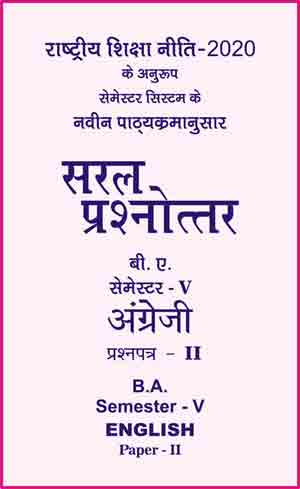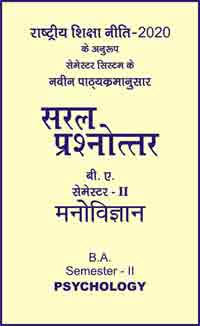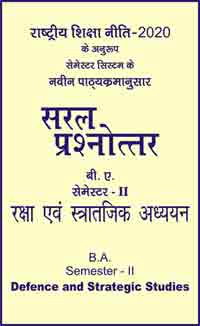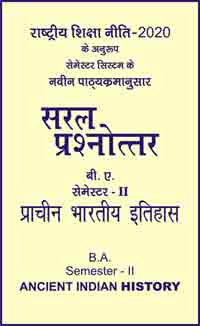|
बी ए - एम ए >> बीए सेमेस्टर-5 पेपर-2 अंग्रेजी बीए सेमेस्टर-5 पेपर-2 अंग्रेजीसरल प्रश्नोत्तर समूह
|
5 पाठक हैं |
|||||||
बीए सेमेस्टर-5 पेपर-2 अंग्रेजी - सरल प्रश्नोत्तर
Question- What is meant by criticism of life? What is the 'vision of life"? Point out the criticism and vision of life in A Tale of Two Cities.
Answer-
According to Henry James, novel "is the most independent, the most elastic, the most prodigious of literary forms". It has certain values, beyond mere entertainment. Life is the principal ingredient of a novel. In fact, all the literary forms are an expression of life. A novelist transmits his vision to others. Even the minutest details of life do not escape the notice of a novelist. Not all novelists, but the good and great ones, have deeply thought about life in all its manifestations. They have deeply thought, and transmitted the thought. Not the trifling events, but the enduring truths, "eternal passion, eternal pain", ripe wisdom, give the novelists a vision of moral significance. Not that the novelists will set forth certain moral or ethical principles. Far from it. The heroes and heroines must not be the embodiments of all kinds of virtues. If so, the novel will be a moral treatise. Moreover, readers by and large may feel alienated, for they cannot love and feel akin to such patterns of virtue. All that is expected from a novel is philosophical significance. Virtues are abstract qualities. A novelist is concerned with facts that are concrete. Dr. Johnson complained that Shakespeare was writing for convenience rather than morality. A host of critics, on the other hand, complained that Shakespeare was positively immoral. Bowdler went so far as to expunge from his plays all that he considered immoral and indecent. And yet the fact remains that Shakespeare dealt with the hard facts of life.
A novelist must not be a moralist, but he must have a philosophy of life. In Shakespeare's Hamlet and King Lear certain lines leap out of the text and just a few words embody the poet's philosophy of life, e.g.,-'Ripenes is all' and 'readiness is all'. They speak volumes. Moulton observes: Every play of Shakespeare is a microcosm, of which the author is the creator and the plot the providential scheme.
In estimating the philosophy of life in a novel, says W.H. Hudson, have to test it from two points of view-that of its truth and that of its morality.
Science deals with facts. A novel, and for the matter of that, every branch of art poetry, drama, novel, short story, painting, sculpture, music, etc., are dealing with truth. Walter Pater, however, says that all art permanently strives towards the condition of music. Plato has banished all poets from his ideal Republic, only because they are twice removed from truth. His disciple Aristotle defends poetry and drama against the wrong allegation. According to Aristotle, 'Poetic truth' is what a poet deals with. On the analogy of truth there may be 'novelistic truth' or 'artistic truth' is different from what Hudson says 'fidelity to facts'. It is Aristotelian 'ideal' probability.
De Quincey draws a distinction between 'literature of knowledge' and 'literature of power'. The former deals with all branches of science. The latter deals with literature that lifts us. It has the quality of the sublime. "The supreme element of truth" is what is conveyed in a work of art, and novel is a major form of art.
Goethe, the great German poet observes: "The artist's work is real in so far as it is always true; ideal, in that it is never actual". This is the criticism of life.
Mathew Arnold in his essay says, "Literature is the criticism of life". In his famous essay on "The study of poetry, he says that poetry is the criticism of life'. What he means is that criticism of life is the profound application of ideas to life.
A Tale of Two Cities is a criticism of life. The French Revolution is supposed to have ushered in the principles of Liberty, Equality and Fraternity. But in reality the French Revolution has not attained the much- hyped ideals. It has become a colossal waste of life. It has been an expression of wanton cruelty, mob fury, violence on a large scale. La Guillotine was constantly at work. The aristocrats were indiscriminately guillotined. Along with them a huge number of innocent people, women and children, all poor and oppressed, were mercilessly slaughtered. The poor Seamstress is a case that illustrates the grimness of this truth.
This cannot be described as an ideal Revolution. The revolutionaries under the leadership of the Defarges were out to crush humanity. But what have they created? Have the lives of the survivors become any the better? That is why Dickens himself draws an indictment against the Revolution.
"Crush humanity out of shape once more, under similar hammers and it will twist itself into the same tortured forms. Sow the same seed of rapacious licence and oppression over again, and it will surely yield the same fruit according to its kind.
Six tumbrels roll along the streets. Change. these back again to what they were, powerful enchanter time, and they shall be seen to be the marriages of absolute monarchs equipages of feudal nobles, the toilettes of flaming Jezebels, the churches that are my father's house, but dens of thieves, the huts of millions of starving peasants! No, the great magician who majestically works out the appointed order of the creator never reverses his transformation.
Dickens sincerely believes that moral regeneration precedes a revolution; or there may not be any need of a Revolution at all. Society is an aggregate of units. The units are the individuals. If the individuals are good, honest, decent, loving their fellowmen, the possibility of a war or Revolution becomes remote. One Sydney Carton does not constitute the society. Greed, lust, passion, love of power cruelty, selfishness misguided men are rampant. Man must have self-introspection. He will understand that while finding motes in others' eyes, he has missed the beam in his own.
Vision of Life in A Tale of Two Cities
Vision of life and criticism of life are almost alike. There is just a degree in the levels of truth. It is in great novels that we get a glimpse of the vision of truth. 'Bad novels' cannot aspire to a vision of life. Such novels are the novels of wish-fulfilment. Readers, particularly those who love romance and glamour, wish that the heroes should do what they expect. Such novels end in wedding bells, moon-lic badinage, the patter of tiny feet. These novels deal with falsification.
In good novels there are no short cuts to happiness. The hero does not evade truth however unpleasant. He widens our imaginative range. But the highest degree of truth does not emerge. In a great novel it does. Emily Bronte in her Wuthering Heights attains the highest degree of truth and vision of life. She lets us know the oneness of primitive passions of man and woman. "I cannot live without my life. I cannot live without my soul"-This sums up the truth of life. The individuals and the giants of history in Tolstoy's War and Peace have an interaction, and there is the vision of life.
Dickens at times becomes grotesque and sentimental. But in A Tale of Two Cities he has caught the vision of life that transcends earthly limitations. Sydney Carton is a man who has that beatific vision. While dying for the sake of love he becomes undying, and lets us have a glimpse of that truth, of that vision:
"I see a beautiful city and a brilliant people rising from this abyss, and in their struggles to be truly free in their triumphs and defeats, through long years to come. I see the evil of this time and of the previous time of which this is the natural birth, gradually making expiation for itself and wearing out."
|
|||||
- Question- Discuss in detail the development of English novel from the eighteenth century to the Modern Age.
- Question- What do you understand by Novel? What are the elements which are to considered in plot construction.
- Question- Write a note on characterization of a novel. How much is it important for development of a novel?
- Question- Write a short note on narrative technique of a novel.
- Question- Write a note on the elements of a short story.
- Question- Write a note on Fielding's plot construction.
- Question- Write a note on Fielding's characterisation.
- Question- Define plot. What are the qualities of an ideal plot ?
- Question- Write a short note on the plot construction of a novel.
- Question- What is the difference between Flat Character and Round Character?
- Question- Write a short note on the characterization of a novel.
- Question- Write a short note on narrative technique of a novel.
- Question- What is a short story? What is the difference between a short story and a novel?
- Question- What is a picaresque novel? Who are the main exponents of the picaresque novel?
- Question- What is a historical novel? What is the difference between history and a historical novel? Name a few historical novelists and their creation.
- Question- What do you know about the Gothic novel?
- Question- Write a note on Epistolary novel.
- Question- Write a note on the Regional novel.
- Question- Point out the chief characteristics of the Picaresque novel.
- Question- Point out the chief characteristics of the historical novel.
- Question- Write an essay on Sir Walter Scott's contribution to historical novel.
- Question- Point out the chief characteristics of Gothic novel.
- Question- Point out the chief characteristics of the Regional novel.
- Question- What is a regional novel? Name a few novelists of this genre and their novels.
- Question- What is a Picaresque novel?
- Question- What do you know about Historical novel?
- Question- What do you know about Gothic novel?
- Question- Examine the merits of Sir Walter Scott as a Historical novelist.
- Question- What do you mean by domestic novel?
- Question- What do you mean by the Stream of consciousness? Who. coined the term?
- Question- What is a Epistolary novel?
- Question- What do you know about the Regional novel?
- Question- Trends in 20th and 21st Century Fiction Discuss as a sub-genre of crime fiction and mystery.
- Question- Define utopian fiction. Discuss its history and origin.
- Question- What is campus novel? Explain its history and development.
- Question- Write a note on Detective novel.
- Question- Write a note on Science fictions.
- Question- Write a note on Meta fiction.
- Question- Define mythology. Explain the rise of mythological fiction in India.
- Question- What is space fiction? Discuss its characteristics and example.
- Question- Define chick lit. Discuss its characteristics and example.
- Question- Define junk fiction. Explain its characteristics and types of junk fiction.
- Question- Write a short note on detective novel.
- Question- Write short note on Science fiction.
- Question- What is Meta fiction?
- Question- What is Science Fiction?
- Question- What is utopian fiction?
- Question- Why are campus novels important? What kind of characters are in campus novels?
- Question- What is dystopian fiction?
- Question- Discuss feminism in mythological fiction.
- Question- Why are campus novels important? What kind of characters are in campus novels?
- Question- What is chic lit fiction?
- Question- Write a note on the life and works of Charles Dickens.
- Question- Write a note on Charles Dickens as a novelist.
- Question- Write a note on the development of English novel up to Dickens.
- Question- Write a note on Dicken's social criticism. What was Dickens' attitude toward various social evils of the day?
- Question- Describe Dickens as a representative of his age.
- Question- Write a note on Dickens as a social reformer.
- Question- Write a note on the social background of Dickens.
- Question- Write a note on Dickens's contribution to English novel.
- Question- Discuss symbolism as a structural elements in A Tale of two cities.
- Question- Discuss Dickens's art of characterization in the novel "A Tale of Two Cities".
- Question- What is meant by criticism of life? What is the 'vision of life"? Point out the criticism and vision of life in A Tale of Two Cities.
- Question- Write a note on the blend of realism and idealism in the novels of Dickens.
- Question- "Dickens' characters are both types and individuals.” Discuss.
- Question- Write a note on Dickens as a satirist.
- Question- What is the significance of the name "Jacques" in A Tale of Two Cities?
- Question- In Book 2, Chapter 21 of A Tale of Two Cities, what is happening in France that upsets Mr. Jarvis Lorry?
- Question- Write the life of Thomas Hardy and about his career.
- Question- What are the three phases of Hardy's writing? What were the issues he dealt with in those three phases?
- Question- Write short notes on the major characters of the novel, and show how Hardy develops these characters in the course of the novel.
- Question- Who is the heroine of 'Far From the Madding Crowd"? How doy o you justify her position as the heroine?
- Question- Explain the tragic vision of Hardy in Far From the Mad ding Crowd.
- Question- Why does Bathsheba reject Gabriel's proposal at the start of the novel?
- Question- How is sexual desire portrayed in the novel?
- Question- How was Oak's life saved by Bathsheba?
- Question- How was Oak completely ruined?
- Question- Describe the feast after sheep-shearing.
- Question- How are Oak and Bathsheba ultimately a happy couple?
- Question- Discuss Jane Austen as a realist.
- Question- Point out Jane Austen's contribution to the English novel.
- Question- Write a note on characterisation of Jane Austen with special reference to 'Pride and Prejudice'.
- Question- Is there artistic detachment in Jane Austen ? Write a brief note in support to your view with illustrations.
- Question- Sketch the character of Fitzwilliam Darcy.
- Question- Sketch the character of George Wickham.
- Question- Do you agree with the view that the novel 'Pride and Prejudice' revolves around two themes of 'Pride and Prejudice'? Give reasons for your answer?
- Question- Write an essay on the sequence of events in 'Pride and Prejudice'?
- Question- Write a note on Life Sketch of George Eliot Life Sketch of George Eliot
- Question- Discuss the humour elements in George Eliot's The Mill on the Floss.
- Question- Critically examine the artistic and the philosophic dimensions of the ending of The Mill on the Floss in the light of the view of the individual and society presented in the novel.
- Question- Compare and contrast Maggie's love for Philip, Stephen, and Tom.
- Question- Describe the thematic import of Maggie's decision to relinquish Stephen.
- Question- Compare and contrast Tom and Maggie. How much are their respective successes and failures a function of gender and how much a function of their distinct characteristics?
- Question- Compare and contrast Tom and Mr. Tulliver. Why does Tom succeed where Mr. Tulliver failed?
- Question- Write a note on life kketch of Toni Morrison.
- Question- Discuss the narrative strategies used by the writer in The Bluest Eye.
- Question- Discuss the narrative structure of the novel. Why might Morrison have chosen to present the events in a non- chronological way?
- Question- What does the title of The Bluest Eye mean?
- Question- How are Pecola Breedlove and Maureen Peal foils to one another?
- Question- The Bluest Eye uses multiple narrators, including Claudia as a child, Claudia as an adult, and an omniscient narrator. Which narrative point of view doyou think is most central to the novel and why?
- Question- Who do you think is the most sympathetic character in the novel and why?
- Question- The Bluest Eye is a novel about racism, and yet there are relatively few instances of the direct oppression of black people by white people in the book. Explain how racism functions in the story.
- Question- Write a note on Life Sketch of The Harper Lee.
- Question- Analyze the childhood world of Jem, Scout, and Dill and their relationship with Boo Radley in Part One.
- Question- What is Atticus's relationship to the rest of Maycomb? What is his role in the community?
- Question- Discuss the role of family in To Kill a Mockingbird, paying close attention to Aunt Alexandra.
- Question- Discuss the author's descriptions of Maycomb. What is the town's role in the novel? Analyze the author's treatment of Boo Radley. What is his role in the novel?
- Question- Discuss Atticus's parenting style. What is his relationship to his children like? How does he seek to instill conscience in them?
- Question- Identify Atticus Finch, Jean Louise (Scout) Finch, Jem Finch, Maycomb, Calpurnia, Charles Baker (Dill) Harris, The Radley Place, Stephanie Crawford, Arthur (Boo) Radley, Miss Caroline Fisher, Walter Cunningham, and Burris Ewell.
- Question- Why did Mr. Cunningham's mob leave?
- Question- In Chapter 2 of To Kill a Mockingbird what does Miss Caroline, Scout's first-grade teacher, represent?
- Question- In Chapter 6 of To Kill a Mockingbird why is Jem is determined to retrieve his pants from the fence despite the danger of meeting up with Nathan Radley?
- Question- What is the significance of the title To Kill a Mockingbird according to Atticus's reasoning in Chapter 10?
- Question - Comment upon the role of the lions in The Old Man And The Sea.
- Question- Comment upon the symbolic role played by Di Maggio in the novel "The Old Man And The Sea'...
- Question- Comment upon the arm-wrestling episode in the novel 'The Old Man and The Sea'.
- Question- Comment upon the marlin separating episode in the novel "The Old Man and The Sea".
- Question- Write a note on the major themes of the novel The Old Man and The Sea'.
- Question- Write a brief note on The Old Man And The Sea' as a tragedy.
- Question- Which claims your attention more in The Old Man And The Sea' its narrative or allegory?
- Question- The hero of the novel "The Old Man And The Sea' is really a Christfigure. Comment.
- Question- Write a brief note on Hemingway hero or the autobiographical hero.
- Question- In the fight of the old man against the giant fish what we see is a "battle of attrition". Comment.
- Question- Write a note on Life Sketh of John Ernst Steinbeck.
- Question- Analyze Tom Joad's growth throughout the novel. Despite the fact that Tom is not a young boy, does the novel have the characteristics of a bildungsroman, or coming-of-age story?
- Question- Discuss the development of Tom Joad as a character. How does he grow throughout the book? What effects do Jim Casy's imprisonment and death have on his development?
- Question-What themes related to family are in The Grapes of Wrath?
- Question- How does the erosion described in Chapter 1 of The Grapes of Wrath relate to the Bank monster described in Chapter 5?
- Question- How do the roles of Ma and Pa differ in the Joad family in The Grapes of Wrath?
- Question- In The Grapes of Wrath how is the Gila monster described in Chapter 13 comparable the Bank monster?
- Question- What biblical allusions does John Steinbeck include in The Grapes of Wrath and how does he use them?
- Question- How do the roles of Ma Joad and Pa Joad within the family change in The Grapes of Wrath?
- Question- In The Grapes of Wrath, why does the Joad family deteriorate after the Joads leave Oklahoma?
- Question- Write a note on Life Sketch of Aravind Adiga
- Question- Discuss plot of the novel The White Tiger.
- Question- Explain literary analysis of The White Tiger by Aravind Adiga.
- Question- Critical analysis of the novel The White Tiger written by Aravind Adiga.
- Question- What is Balram's attitude toward religion? How does this develop throughout the novel?
- Question- How does this portrayal of India differ from more typical literary depictions of India?
- Question- Why does Balram choose to address his narrative to the Premier of China? How would the story have been different without this framing device?
- Question- Discuss Balram's many names throughout the novel, and how each one represents an aspect of him.
- Question- What does Balram's experience in Bangalore reveal about the Indian economy in an increasingly globalized world?
- Question- Attempt critical analysis of the novel 'Dalits, Dynasty and She' by Sanjay Chitranshi.
- Question- Explain the plot of the novel 'Dalits, Dynasty and She 'written by Sanjay Chitranshi.
- Question- Discuss the Novel 'Dalits, Dynasty and She' by Sanjay Chitranshi.
- Question- Who was Shanti Devi?
- Question- Write a' character sketch of Ram Chandra.
- Question- Write a note on Life Sketch of Sudha Murty.
- Question- What are the major themes of the novel "Dollar Bahu"?
- Question- Discuss how the notion of self sacrifice is exclusively attributed to a particular gender in Indian society. How they thrive through the difficult situation in life when they are implanted to a new atmosphere.
- Question- Write a note on the title "Dollar Bahu?".
- Question- Write a note on the end of the novel "Dollar Bahu".
- Question- Discuss the central theme of Dollar Bahu.














